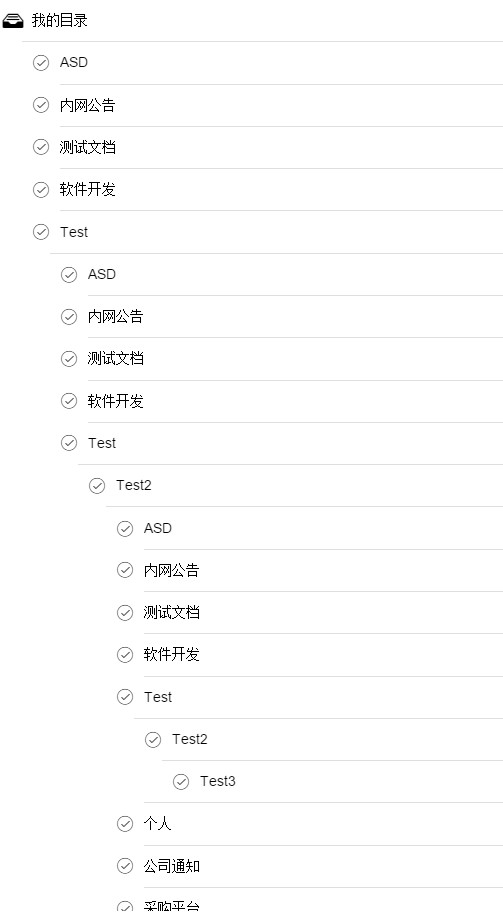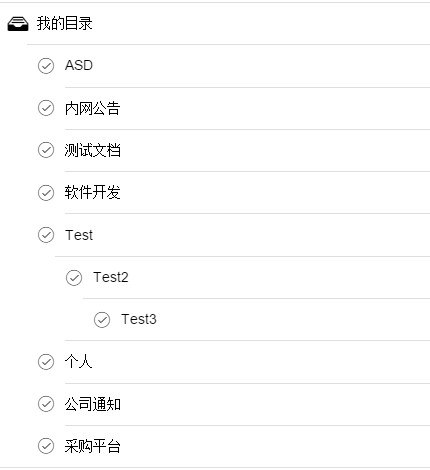Example analysis of javascript scope problem_javascript skills
During a recent project, I needed to generate a tree-like directory based on JSON data. The resulting code is as follows:
var folderList=[
{
"FolderName": "ASD",
"ChildList": null
},
{
"FolderName": "内网公告",
"ChildList": null
},
{
"FolderName": "测试文档",
"ChildList": null
},
{
"FolderName": "软件开发",
"ChildList": null
},
{
"FolderName": "Test",
"ChildList": [
{
"FolderName": "Test2",
"ChildList": [
{
"FolderName": "Test3",
"ChildList": null
}
]
}
]
},
{
"FolderName": "个人",
"ChildList": null
},
{
"FolderName": "公司通知",
"ChildList": null
},
{
"FolderName": "采购平台",
"ChildList": null
}
];
var str='';
function generateFolders(arr) {
if (arr.length > 0) {
str += '<div class="sui-list sui-list-icon ubt bc-gra1">';
for (var i = 0, len = arr.length; i < len; i++) {
str += '<ul class="ub ub-ac">'
+ '<li class="sui-list-licon sui-icon-ok-circle fts2">' + '</li>'
+ '<ul class="ub ub-f1 sui-list-item">'
+ '<li class="ub-f1 sui-list-text sui-list-nowrap">' + arr[i].FolderName + '</li>'
+ '<li class="sui-list-ricon ub-img sui-icon-chevron-right fts2"></li>'
+ '</ul>'
+ '</ul>';
if (isDefine(arr[i].ChildList)) {
str += generateFolders(arr[i].ChildList);
}
}
str += '</div>';
return str;
}else{
return '';
}
}
var folderTxt ='<div class="sui-list sui-list-icon ubt bc-gra1">'
+'<ul class="ub ub-ac">'
+'<li class="sui-list-licon sui-icon-drawer fts2">' + '</li>'
+'<ul class="ub ub-f1 sui-list-item">'
+'<li class="ub-f1 sui-list-text sui-list-nowrap">我的目录</li>'
+'<li class="sui-list-ricon ub-img sui-icon-chevron-right fts2"></li>'
+'</ul>'
+'</ul>';
folderTxt+=generateFolders(folderList);
folderTxt += '</div>';
$('#list').html(folderTxt);
/**
* 判断是否是空
* @param value
*/
function isDefine(value){
if(value == null || value == "" || value == "undefined" || value == undefined || value == "null" || value == "(null)" || value == 'NULL' || typeof(value) == 'undefined'){
return false;
}
else{
value = value+"";
value = value.replace(/\s/g,"");
if(value == ""){
return false;
}
return true;
}
}
The resulting tree is as shown below:

After investigation, it was found that the problem was caused by the incorrect location of str definition. Just define str as a local variable.
function generateFolders(arr) {
var str='';
if (arr.length > 0) {
str += '<div class="sui-list sui-list-icon ubt bc-gra1">';
for (var i = 0, len = arr.length; i < len; i++) {
str += '<ul class="ub ub-ac">'
+ '<li class="sui-list-licon sui-icon-ok-circle fts2"></li>'
+ '<ul class="ub ub-f1 sui-list-item">'
+ '<li class="ub-f1 sui-list-text sui-list-nowrap">' + arr[i].FolderName + '</li>'
+ '<li class="sui-list-ricon ub-img sui-icon-chevron-right fts2"></li>'
+ '</ul>'
+ '</ul>';
if (isDefine(arr[i].ChildList)) {
str += generateFolders(arr[i].ChildList);
}
}
str += '</div>';
return str;
}else{
return '';
}
}
After modification, the desired effect can be achieved:

The above is the entire content of this article, I hope you all like it.

Hot AI Tools

Undresser.AI Undress
AI-powered app for creating realistic nude photos

AI Clothes Remover
Online AI tool for removing clothes from photos.

Undress AI Tool
Undress images for free

Clothoff.io
AI clothes remover

AI Hentai Generator
Generate AI Hentai for free.

Hot Article

Hot Tools

Notepad++7.3.1
Easy-to-use and free code editor

SublimeText3 Chinese version
Chinese version, very easy to use

Zend Studio 13.0.1
Powerful PHP integrated development environment

Dreamweaver CS6
Visual web development tools

SublimeText3 Mac version
God-level code editing software (SublimeText3)

Hot Topics
 Usage of typedef struct in c language
May 09, 2024 am 10:15 AM
Usage of typedef struct in c language
May 09, 2024 am 10:15 AM
typedef struct is used in C language to create structure type aliases to simplify the use of structures. It aliases a new data type to an existing structure by specifying the structure alias. Benefits include enhanced readability, code reuse, and type checking. Note: The structure must be defined before using an alias. The alias must be unique in the program and only valid within the scope in which it is declared.
 How to solve variable expected in java
May 07, 2024 am 02:48 AM
How to solve variable expected in java
May 07, 2024 am 02:48 AM
Variable expected value exceptions in Java can be solved by: initializing variables; using default values; using null values; using checks and assignments; and knowing the scope of local variables.
 Advantages and disadvantages of closures in js
May 10, 2024 am 04:39 AM
Advantages and disadvantages of closures in js
May 10, 2024 am 04:39 AM
Advantages of JavaScript closures include maintaining variable scope, enabling modular code, deferred execution, and event handling; disadvantages include memory leaks, increased complexity, performance overhead, and scope chain effects.
 What does include mean in c++
May 09, 2024 am 01:45 AM
What does include mean in c++
May 09, 2024 am 01:45 AM
The #include preprocessor directive in C++ inserts the contents of an external source file into the current source file, copying its contents to the corresponding location in the current source file. Mainly used to include header files that contain declarations needed in the code, such as #include <iostream> to include standard input/output functions.
 C++ smart pointers: a comprehensive analysis of their life cycle
May 09, 2024 am 11:06 AM
C++ smart pointers: a comprehensive analysis of their life cycle
May 09, 2024 am 11:06 AM
Life cycle of C++ smart pointers: Creation: Smart pointers are created when memory is allocated. Ownership transfer: Transfer ownership through a move operation. Release: Memory is released when a smart pointer goes out of scope or is explicitly released. Object destruction: When the pointed object is destroyed, the smart pointer becomes an invalid pointer.
 There are several situations where this in js points to
May 06, 2024 pm 02:03 PM
There are several situations where this in js points to
May 06, 2024 pm 02:03 PM
In JavaScript, the pointing types of this include: 1. Global object; 2. Function call; 3. Constructor call; 4. Event handler; 5. Arrow function (inheriting outer this). Additionally, you can explicitly set what this points to using the bind(), call(), and apply() methods.
 Can the definition and call of functions in C++ be nested?
May 06, 2024 pm 06:36 PM
Can the definition and call of functions in C++ be nested?
May 06, 2024 pm 06:36 PM
Can. C++ allows nested function definitions and calls. External functions can define built-in functions, and internal functions can be called directly within the scope. Nested functions enhance encapsulation, reusability, and scope control. However, internal functions cannot directly access local variables of external functions, and the return value type must be consistent with the external function declaration. Internal functions cannot be self-recursive.
 The difference between let and var in vue
May 08, 2024 pm 04:21 PM
The difference between let and var in vue
May 08, 2024 pm 04:21 PM
In Vue, there is a difference in scope when declaring variables between let and var: Scope: var has global scope and let has block-level scope. Block-level scope: var does not create a block-level scope, let creates a block-level scope. Redeclaration: var allows redeclaration of variables in the same scope, let does not.






